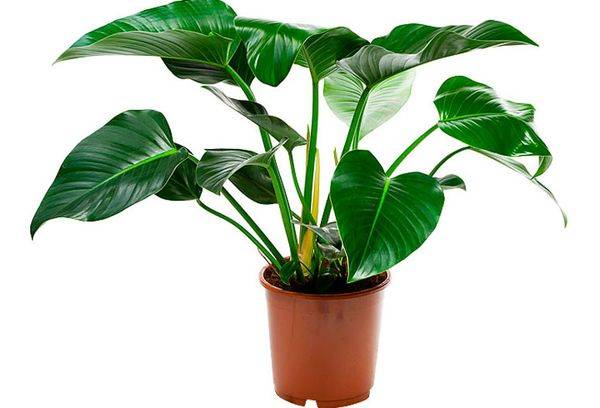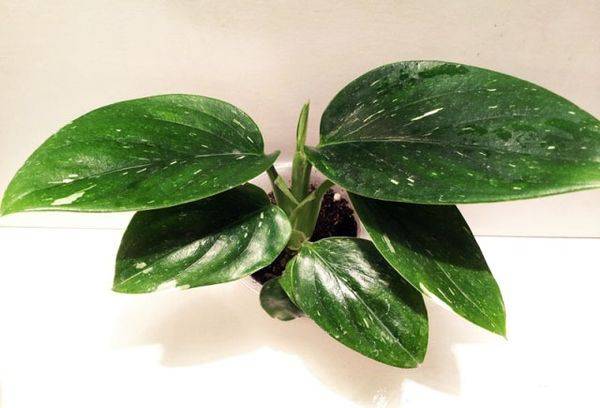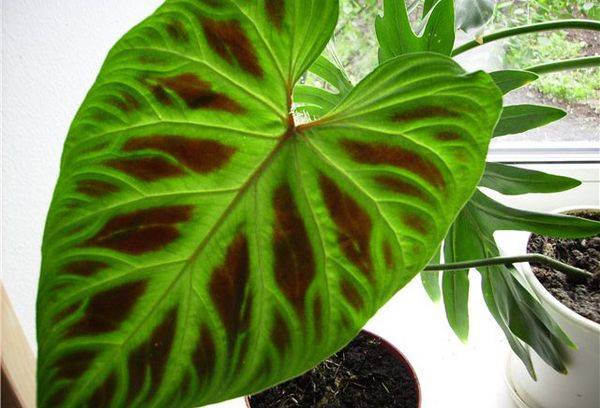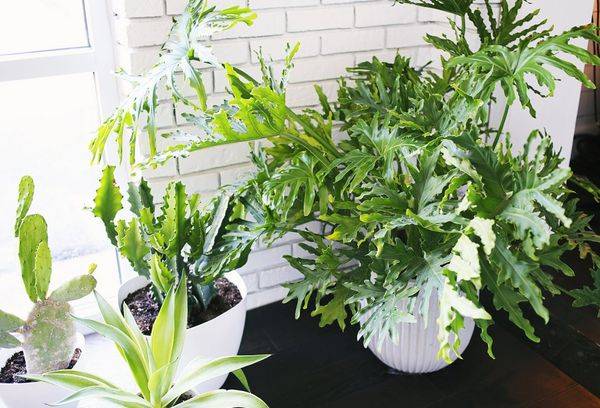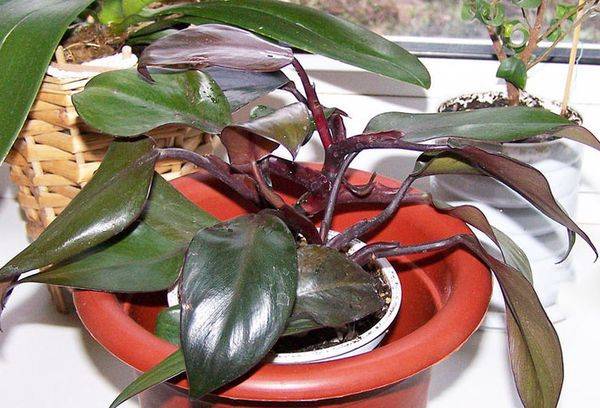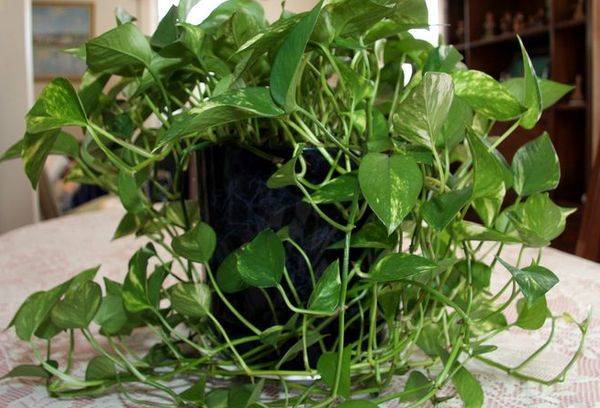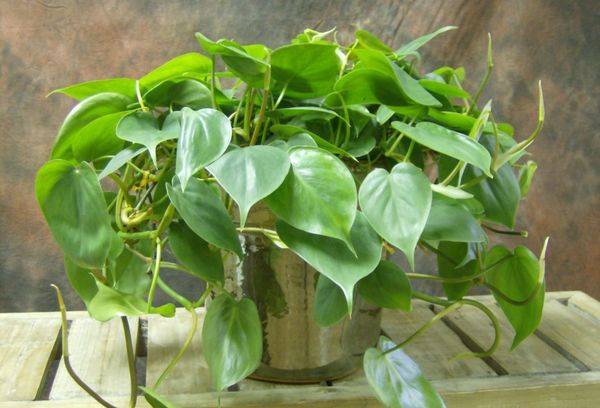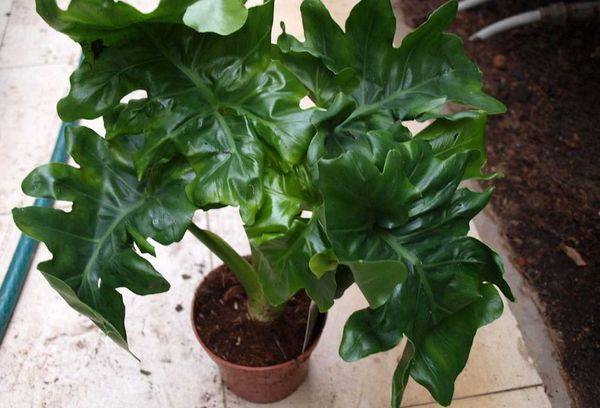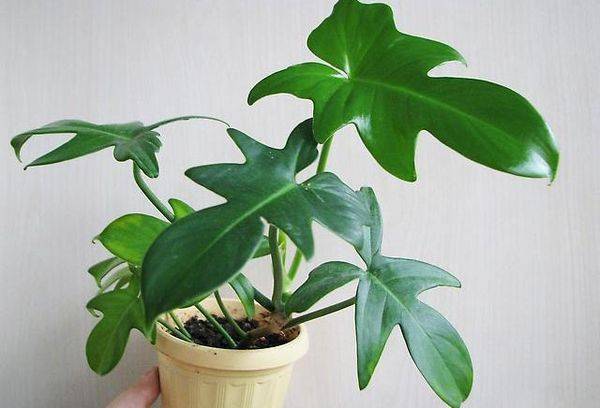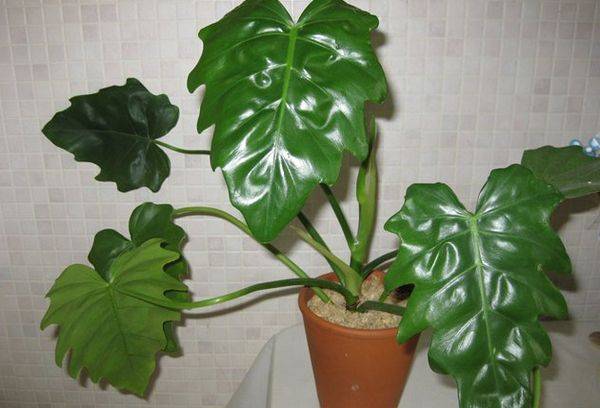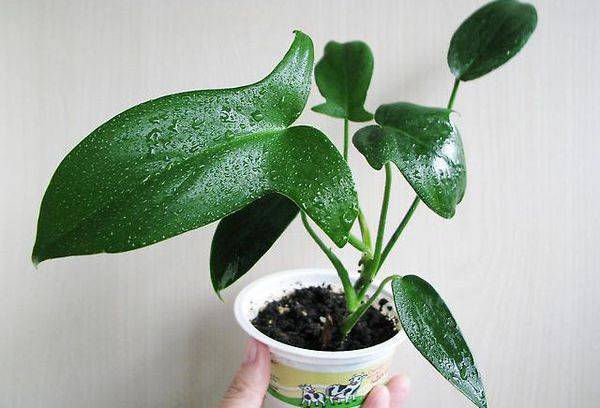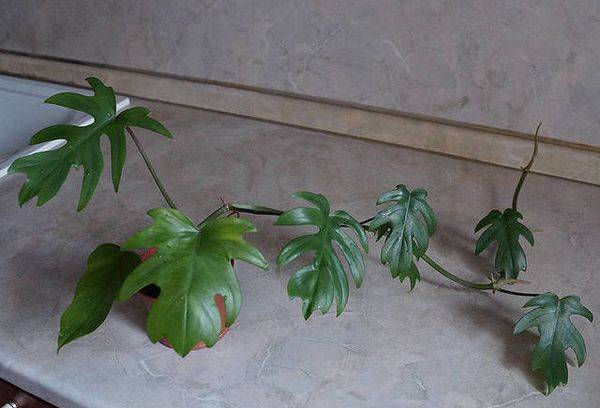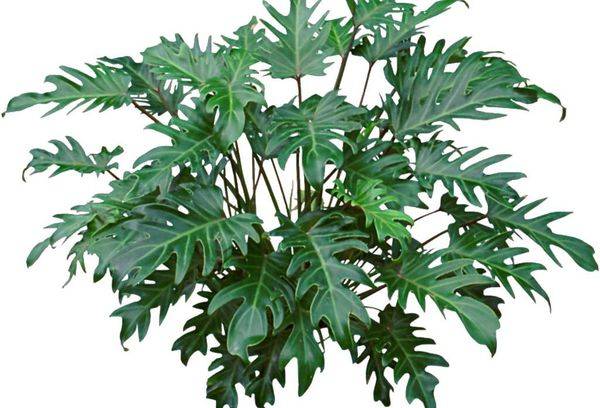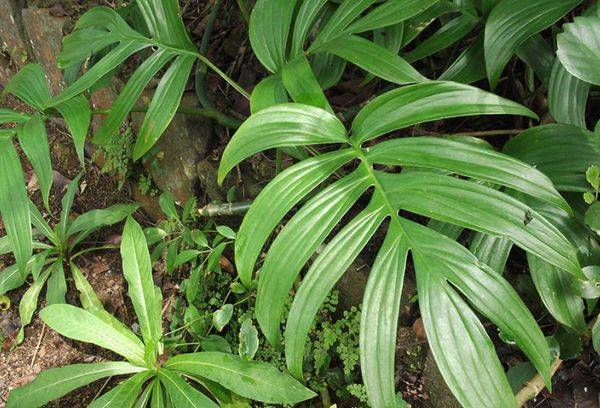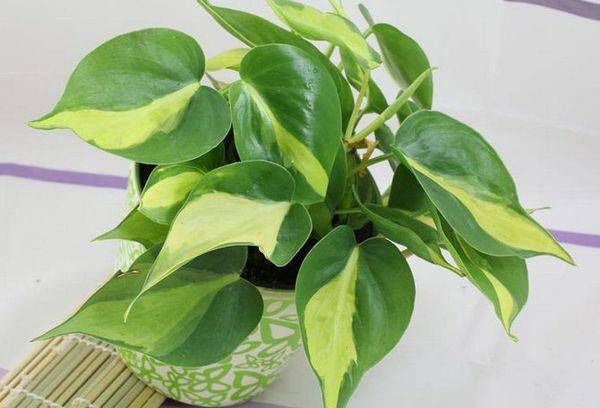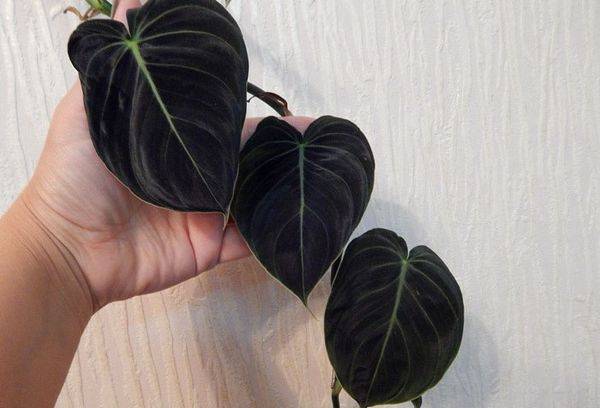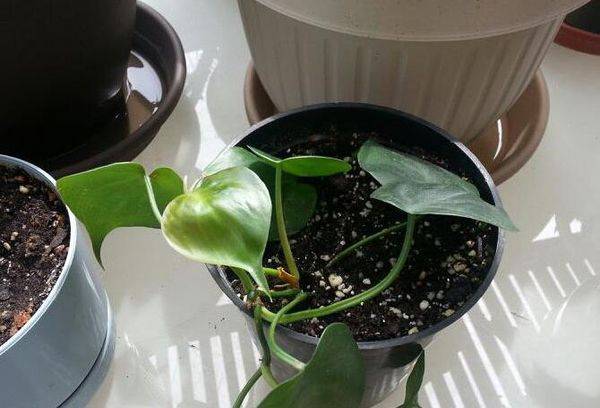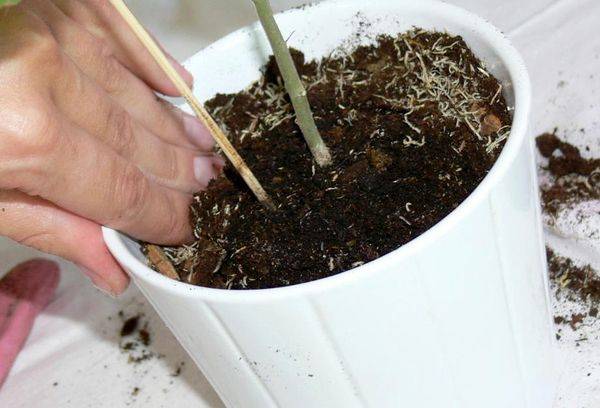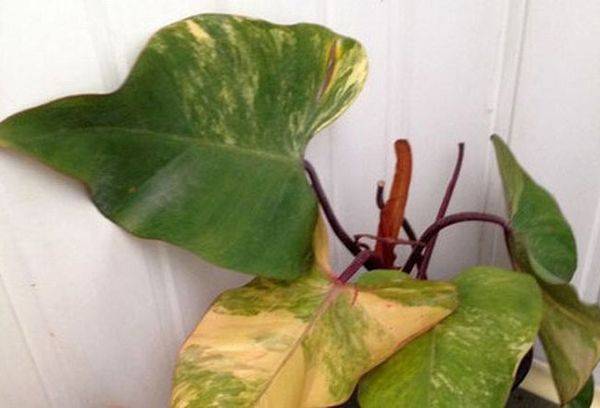How to care for a philodendron at home
Content:
Philodendron is one of the most common plants grown indoors. This is due to the beauty of the appearance of the flower and the fact that caring for the philodendron is simple, even an inexperienced grower can cope with it.
Plant description
Under natural conditions, philodendron grows in Australia, Mexico and the tropical forests of South America. The genus Philodendron is diverse: vines, shrubs, land plants, half epiphytes, epiphytes, more than four hundred species of philodendron are known.
The root system of representatives of the genus is highly branched and is located close to the surface. On the stem at the base on the internodes, air roots are formed, the function of which is to attach to the support and supply the plant with nutrients.
The stem is thin, its length varies from a couple of centimeters to two to three meters. Bottom shoot over time lignified, covered with a brown bark. In adult plants, the wood is dense, so there is no need for support.
The leaves grow again, are located on the petioles, in some cases the length of the leaf plate is two meters. During the life cycle, the leaf shape of one plant can change more than once, it is oval, dissected, swept or palmate. For different types of leaf plates are different in structure, structure, shape and color. Color varies from brown with a red tint to green, variegated species are found.
In addition to the usual leaflets, cataphillas grow on the philodendron - small leaf plates in the form of scales, the function of which is to protect the vegetative buds. When the leaves fall on the stem, dimples remain in the place where the petioles were attached.
The inflorescence of the philodendron has the appearance of a cob up to 25 cm long. When the plant blooms, one to eleven inflorescences are formed on it, which are placed separately or in groups.
The fruit of the philodendron is a berry that ripens up to one year. A ripe berry of yellow, white or greenish color, inside it there are seeds, dense and very small.
Types and varieties of home philodendron
Some types of philodendron grow in very large sizes and are used to decorate large halls, vestibules, conservatories. Others are compact and perfect for growing in a home or apartment.
Popular types and varieties:
- Philodendron warty. It differs in soft shoots that spread along the surface of the soil. Petioles, on which the leaves are located, are dotted with warty setae. The leaf plates are velvety, have a heart-shaped, up to 20 cm long, about 10 wide, dark green in color, a bronze brown pattern spreads along the veins. The inflorescence is closed by a yellowish hue, approximately 7 cm long. The view does not tolerate dry indoor air.
- Philodendron bicopus and Philodendron Sello - two different species, but very similar to each other, so they are often confused. Large plants with emerald color, deeply cut glossy leaves up to 70 cm long. Sello is considered the most decorative of large types of philodendron and suitable for growing at home, grows up to two meters in height. It blooms extremely rarely, but very beautifully, a flower up to 8 cm long, inside it is yellow, outside it is green.
- Philodendron blushing. Several varieties of this species are on sale: Red Emerald, Medusa, Burgundy, Mandandaum.Not very large (fragile, thin shoots reach 1.8 m), elegant plant, feature - dark red petioles and the lower part of the leaves (insufficient lighting leads to a loss of bright color). Leaf plates up to 30 cm long, up to 25 wide, green, shiny, swept. When growing, the mind needs support. Over time, the shoots lumber and become a thick vertical trunk.
- Philodendron climbing. It is a flexible vine with thin stems and large dense leaves of a heart-shaped shape of dark green color, 15 cm long and 10 wide. Plants of the species are often used as ampelous plants, are characterized by fast good growth, they can be grown in shaded places, and take root well in hanging baskets.
- Philodendron is ivy. Creeping plant with a stalk up to 6 m long, on which, in the next order, leaves are arranged, heart-shaped, dark green, up to 30 cm long, glossy or leathery. The ear of inflorescence is reddish, surrounded by a greenish-colored bedspread.
- Philodendron atom. It is compact, grows slowly, it requires complex care. Decorative flower is provided by bright five-fingered wavy green leaves with a shiny surface. The length of the sheet plate reaches 30 cm.
- Philodendron is guitar-like. This is a vine that loves high humidity, grows up to two meters in length. A flexible stem needs support. The leaves are dark green, shiny, young in shape resembling a heart, which narrows over time, turning into a kind of guitar.
- Philodendron Evans. It has a very spectacular appearance due to foliage: young leaves are brownish-green with green veins, over time, the brownish tint disappears. Leaf plates grow up to 80 cm long and 50 cm wide.
- Philodendron lobed. Liana with a thick flexible shoot on which petiolate ovoid leaves of dark green grow. Over time, the leaf plates become dissected initially into three, and later into five parts, reach a length of 40 cm.
- Philodendron radiant. Undemanding care vine, grows very quickly. Its length can reach three meters. The leaves are dissected, stiff, up to 20 cm in length.
- Philodendron Xanadu. Woody appearance, undemanding to air humidity and light exposure, but the leaves will be beautiful only if these indicators are at the optimal level. It can bloom in indoor conditions. The leaves are bright, green, up to 40 cm long, over time they become cirrus.
- Philodendron is graceful. It has one large, flexible shoot and oval, wide leaves up to 70 cm long. Leaf plates are dissected, dark green. The inflorescence is wrapped in a creamy green petal with a pink border. Suitable for growing in large rooms or greenhouses.
- Philodendron Skandens. It grows excellently in partial shade and shadow, has flexible, curly shoots. Leaves are heart-shaped, glossy, from 9 to 16 cm long.
- Philodendron is golden black. A plant with velvety beautiful leaves of dark green color with gold streaks, on the underside leafy plates are red. For a good development, the flower will need to create good lighting and provide increased air humidity, which is often difficult in an apartment. For this reason, the plant is more common in greenhouses.
- Philodendron Imperial. It has 2 varieties: imperial red and imperial green. Forms a stalk with short internodes. The leaves are large, collected in a rosette with a diameter of up to 1 m. Young leaves of the red variety are of intense red color (when the light is poor, the color fades), the green variety has green leaves. View tolerates too dry air in the room.
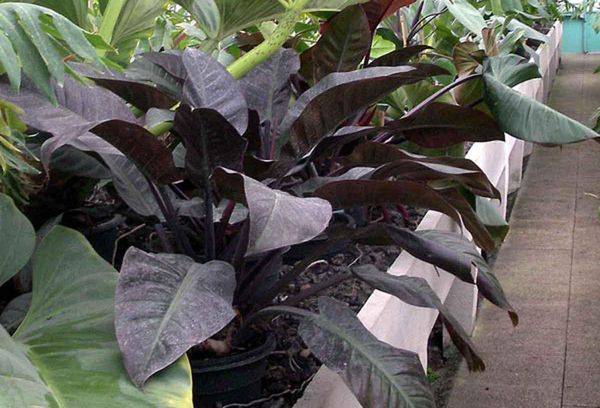
Philodendron imperial
Home Care
It is not difficult to take care of the philodendron, no special skills and knowledge will be required for the grower.It must be taken into account that over time, the flower increases significantly in size, and it will need space.
Tip
In the summer heat, spray the flower more often and ventilate the room.
- Lighting. The plant perfectly develops in close proximity to the western or eastern window. The light should be bright, but diffused. Direct sunlight often causes burns, and if the room is too dark, the leaves will lose their bright color.
- Temperature. The optimum mode for the philodendron is from +17 to + 24 ° C. The plant does not tolerate drafts and a sharp change in air temperature. In the winter months, the thermometer should not fall below + 13 ° C.
- Humidity. Philodendron grows best if the humidity is high, for this reason daily spray the crown of a flower from a spray bottle. It will not be superfluous to place saucers with wet expanded clay or water next to the pot. Regularly arrange a shower of plants, as the dust accumulated on the leaves makes gas exchange difficult. Some varieties of philodendron are extremely sensitive to dry air in the room (for example, warty).
- Watering. The plant needs frequent and plentiful watering. The water should be well purified and warm. Drain excess fluid immediately from the drip tray. Soil should not turn into a swamp, but it is necessary to constantly keep it in a wet state. If the air temperature is low (about + 13 ° C), stop watering.
- Priming. The soil mixture must be breathable and loose, as some species live on trees. Acidity is most preferably neutral or slightly acidic.
- Top dressing. Fertilize the soil mixture from May to September, from two to four times a month (for the season there should be from 6 to 12 fertilizing, that is, about 1 time in 2 weeks). As a fertilizer, use an organic compound strongly diluted with water (30-50% of the usual dosage). The rest of the time, feed the plant 1 or 2 times a month with a mineral complex. Young plants, planted in fertile soil, need feeding more rarely.
Tip
To protect the plant from the appearance of rot, add a little charcoal and moss to the soil.
Heavy soil is contraindicated in philodendron. There are several options for soil mixtures in which the flower will grow and develop perfectly:
- pieces of pine bark, sand or perlite, lowland peat and garden land;
- turf and leaf soil, sand;
- purchased ready-made substrate designed specifically for growing philodendron.
Be sure to put a layer of expanded clay or broken brick at the bottom of the pot, so the plant will be provided with good drainage.
Tip
Variegated species of philodendron can not be fed with complex fertilizers, which contain a large amount of nitrogen.
Home care is to ensure optimal temperature, lighting, humidity and frequency of irrigation.
Reproduction and transplantation
At home, philodendrons bloom in very rare cases, for reproduction from seeds, several plants will be required, for this reason, the seedlings are done in a vegetative way. To do this, take the apical and stem cuttings with 2-3 internodes, lay horizontally on sandy peat soil and deepen at an angle of about 45 degrees. Cover the container with cuttings with plastic wrap and leave at a temperature of 25 ° C. The roots will appear within 7-30 days.
Tip
Rooting will occur much faster if there are aerial roots on the internodes of the cuttings.
Species with a lignified stem (for example, xanadu) are propagated by horizontal layering. To do this, damage the bark on the side shoot, then wrap it with sphagnum, which must be periodically moistened. After the appearance of the roots (after 2-3 weeks), cut the process and plant in a separate container.
Relocate the plant at least once every 3 years, the optimal time is February, March.Renew the topsoil in the tank annually. Philodendrons feel great in a tight pot, so choose a compact container for transplantation.
Immediately after planting, place the plant in a shaded area and reduce watering. Adaptation of the flower to the changed growing conditions will occur in 2 weeks.
Diseases and Pests
If optimal conditions are created for the growth and development of philodendron, then it is not damaged by pests. The main enemies of the plant are thrips, scale insects, mealybugs, spider mites and aphids. All of them settle on the leaves.
Tip
To get rid of pests, purityis.decorexpro.com/en/ recommends removing insects with a sponge dipped in soapy water. Rinse off the soap with clean, warm water.
A strong pest lesion is eliminated with a solution of karbofos (take 1-30 drops of the drug per 1 liter of water). After a week, repeat the treatment.
Mustard solution will help get rid of sucking plant juices. Take 60 g of spices, dissolve in 1 liter of water and leave for three days. Before use, dilute the resulting infusion with 20 liters of water.
Useful Tips
The recommendations of experienced gardeners will help in time to identify and eliminate errors in the care of the philodendron:
- Yellowing of the leaves of the plant is the result of excessive watering. As a result of overflow, stem rot occurs. The flower will have to be transplanted, watering must be reduced.
- If the leaves turn yellow, but stem rot is excluded, then the plant is lacking in nutrients.
- A pale leaf color indicates an excess of sunlight.
